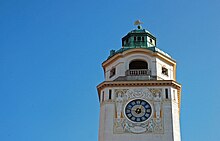Müllersches Volksbad
| Müller'sches Volksbad | |
|---|---|
 Exterior view |
|
| Data | |
| place | Munich |
| builder | Carl Hocheder |
| Construction year | 1901 |
| Coordinates | 48 ° 7 '55.5 " N , 11 ° 35' 18" E |
| particularities | |
| Art Nouveau bathroom | |
The Müllersche Volksbad (actually: Müller'sches Volksbad) in Munich is an indoor swimming pool with a sauna, which is operated by the Stadtwerke München (SWM) . The neo-Baroque Art Nouveau was at its completion in 1901, the largest and most expensive swimming pool in the world and the first public swimming pool in the city. The construction goes back to a donation from the Munich engineer Karl Müller to the city of Munich, combined with the requirement to build a bathroom for the "poor people". The building was based on a design by Carl Hocheder . With its architecture and interior design, the bathroom is one of the most beautiful bathhouses in Europe.
description
The Volksbad is located at the beginning of Rosenheimer Straße in the Au between Isar and Auer Mühlbach in the immediate vicinity of the Deutsches Museum and the Ludwigsbrücke . The building stands directly on the Isar and has a clock tower in which there is reserve water that keeps the water pressure constant. The bathroom has two swimming pools.
The larger pool (31 × 12 m) was originally the " men's pool ". The smaller pool (18 × 11 m) served exclusively as a "ladies pool" until 1989 . It is still tempered a bit today and has a nice massage water inlet. Traditionally there is still a women's bathing day (Tuesdays from 3 to 8 p.m.) in the women's hall. Both pools are separated along an axis that is a mental continuation of the path to the swimming pool. The large basin is crowned by an impressive barrel vault. In the "ladies' pool" there are wooden cabins arranged around the pools on floors with galleries. They grant direct access to the bathing area.
Since its construction, the bath has contained a Roman-Irish steam bath with an open-air courtyard. The Roman-Irish sweat bath (approx. 45 ° C) is equipped with warm and hot air rooms at different temperatures (approx. 40 ° C, approx. 60 ° C and approx. 80 ° C). It is supplemented by a steam bath (approx. 45 ° C), Finnish sauna (approx. 90 ° C) with colored lights, cold pool, warm pool (approx. 34 ° C) and relaxation areas. A room with loungers is available on the upper floor for relaxation between sauna sessions. Massages are offered.
history
The architect Carl Hocheder had previously built the shower bath in Haidhausen in Munich . He was now inspired by a variety of models: Roman thermal baths such as baroque sacred buildings, hammams and mosques, all held together by contemporary Art Nouveau elements. The facade is structured by window reveals and cornices on Pollinger tufa . The rich baroque decorative elements inside include wide stairs that lead down into the basin, wall paintings with marine motifs, stucco, a bronze statue in the main basin, ornate iron grilles and wooden parapets as well as elaborately designed clocks. The design of the decorative elements was carried out by Ernst Pfeifer, Hermann Hahn, Josef Flossmann , Ernst Andreas Rauch and others. There are three exhaust air openings in the ceiling through which cold water was atomized in the bathroom in hot weather when it was founded, which, according to Hoheneder, also made for a “graceful embellishment through the formation of rainbow colors”. After a construction period of four years, the official opening took place on May 1, 1901. The engineer Karl von Müller, who had meanwhile been raised to the nobility by the Prince Regent , was present.
Until 1978 there was a dog bath in the basement, as well as 86 baths and 22 shower baths at the beginning. After bathtubs and showers became widespread in private households in the 20th century, the bathroom finally shut down these facilities, kept an original bathtub for demonstration purposes and set up a new bathtub and shower in the basement on a far more modest scale.
The most extensive renovations took place between 1972 and 1999 and affected all parts of the bathroom. The Stadtwerke München comment on this: "In loving and laborious detail work, almost every detail has been preserved true to the original to this day."
Film set
- Essential sequences of the feature film Deep End (1971) and the film Suspiria (1977) were shot in the Müller Volksbad.
literature
- Günter Standl, Rupert Bachmann: Müller'sches Volksbad. Rosenheimer Verlagshaus , 2001, ISBN 3-475-53164-X .
- Barbara Hartmann: The Müller'sche Volksbad in Munich. tuduv-Verlagsgesellschaft, 1987, ISBN 3-88073-235-3 .
- Peter Klimesch: Isar lust. Discoveries in Munich. MünchenVerlag, Munich 2011, ISBN 978-3-937090-47-4 .
- Karl Hocheder: The Müller'sche Volksbad in Munich. In: Deutsche Bauzeitung. XXXVI. Volume, No. 70, August 30, 1902, pp. 445-447. (Digitized version) ; No. 71, September 3, 1902, p. 453; No. 72, September 6, 1902, p. 458. (digitized version ) on opus4.kobv.de
- B. Kurtz: Müller'sches Volksbad in the mirror of the century . Dersch Druck, 2001.
- R. Schachner, G. Wimmer: Munich's public bathing establishments . Pareus, Munich 1908.
- (Anonymous): Munich urban architecture from the last decades - II. Public health buildings - The Karl Müller'sche Volksbad. Callway, Munich 1912.
Web links
Individual evidence
- ↑ a b c d e f SWM: Müllersches Volksbad | Indoor swimming pool | Haidhausen, Munich. Stadtwerke München, 2020, accessed on February 19, 2020 .
- ^ Günter Standl, Rupert Bachmann: Müller'sches Volksbad. 2001, p. 25.
- ↑ City Archives Munich: Münchner Stadtchronik 1901 , accessed on May 8, 2010.


